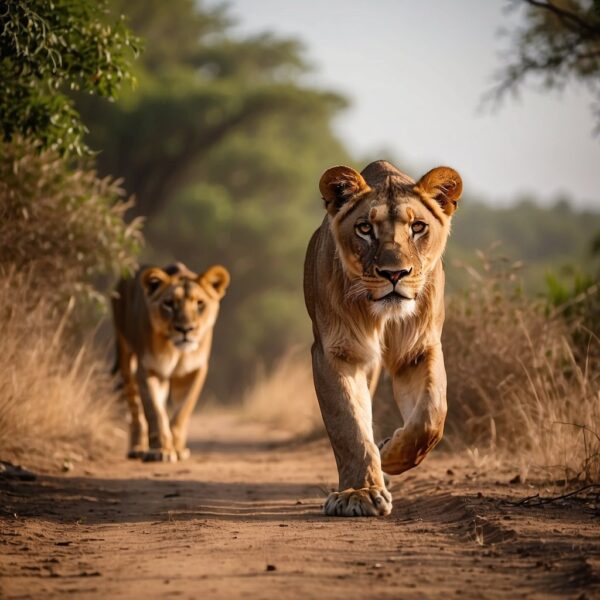
Asiatic Lions: An Overview of Their Conservation Status
The Asiatic lion is a rare subspecies of lion, scientific name Panthera leo leo, found exclusively in the Gir Forest of Gujarat, India. They are genetically distinct from the African lions commonly recognized around the world. Historically, Asiatic lions roamed across the Middle East and Asia, but extensive hunting and habitat loss confined them to a single sanctuary in India. Today, they are a symbol of conservation success due to the significant efforts made to preserve their population.
Preserving the Asiatic lion has been a priority due to their critically reduced numbers. These lions are smaller than their African counterparts, with a characteristic fold of skin on their undersides and sparser manes on males. Their adaptation to the dry forest and scrubland of the Gir landscape showcases their distinct ecological niche. Despite their rebounded population, ongoing conservation efforts are crucial in maintaining the species, with continuous monitoring of their numbers, habitat, and genetic health.
Key Takeaways
- The Asiatic lion is a distinct subspecies found only in India’s Gir Forest.
- Adaptive features and a smaller size distinguish these lions from African lions.
- Conservation efforts have been pivotal in preventing the extinction of Asiatic lions.
asiatic lion Taxonomy and Evolution
Asiatic lions, classified scientifically as Panthera leo persica, are a subspecies of the lion within the Felidae family. Understanding their taxonomy and evolutionary history is pivotal in grasping their unique position within the larger context of big cats.
Species Classification
Panthera leo persica, also known as the Persian lion, was first described by Johann N. Meyer in 1826. It falls under the genus Panthera, a key member of the family Felidae. Initially coined as Felis leo persicus, its nomenclature has since evolved to reflect its specific lineage within the Panthera genus, indicating a clear separation from other lion subspecies. Panthera leo persica remains the only Asian representative of its species, being primarily confined to India’s Gir Forest in the modern era.
The broader classification of lions has undergone changes over time, with research contributing to a nuanced understanding of both extinct and current populations. Lions from Asia and separate populations from Africa were once assumed to combine under a single species: Panthera leo. However, molecular studies indicate a complex historical distribution and suggest a distinction between the subspecies found in Africa and those from Asia.
asiatic lion Historical Range
Historically, the range of Panthera leo extended across large parts of Asia, from the Middle East, encompassing Mesopotamia, to Europe, reflecting a more substantial presence than today. Over time, the Asiatic lion’s domain shrank dramatically due to human activities and environmental factors. The subspecies survived predominantly in Persia, hence the origin of its scientific name reflecting its former range. Today, the last remaining natural habitat of Panthera leo persica is significantly reduced, with conservation efforts focusing on a single population in the Gir Forest of India, a reminder of the Asiatic lion’s once expansive territory across Asia and beyond.
asiatic lion Physical Characteristics
The Asiatic lion exhibits distinct physical features that differentiate it from its African counterparts, including a less pronounced mane in males and a characteristic longitudinal fold of skin on its belly.
Size and Morphology
| Feature | Males | Females |
|---|---|---|
| Weight | Approximately 110-190 kg | Generally lighter than males |
| Height | About 110 cm at the shoulder | Slightly shorter than males |
| Tail | Features a tuft at the end | Likewise, bears a tufted tail |
Asiatic lions have the capacity to roar—though their roars are often considered less thunderous than African lions. The distinct longitudinal fold of skin along their belly is absent in African lions and serves as an identifier for the Asiatic variety.

Distribution and Habitat
Asiatic lions, are now found exclusively in the Gir Forest region of Gujarat, India. Their distribution is limited to this area, having once ranged across other regions of Asia and even parts of Africa.
Gir National Park
Gir National Park, the sole home of the Asiatic lion, is situated in the Indian state of Gujarat. It spans an area of approximately 1,412 square kilometers. The park encompasses a mixture of dry deciduous forests and grasslands, providing an ideal habitat for Asiatic lions. Within the park, these lions have established territories that they patrol and mark.
Gir is uniquely adapted to support Asiatic lions with its water bodies, rich flora that sustains a variety of prey animals, and rugged terrain, which offers shelter and seclusion for these big cats. The region’s management and conservation efforts have been pivotal in fostering a suitable environment for increasing the population of Asiatic lions from the brink of extinction.
Geographical Spread
Historically, the Asiatic lion inhabited much of Southwest Asia and even parts of Eastern Europe. However, their geographical spread has drastically reduced over time. The reduction in territory is a result of hunting, habitat destruction, and human encroachment. Presently, their distribution is limited to the Gir Forest, a significantly reduced range from their extensive historical habitat which included regions outside of India.
The current restricted range emphasizes the vulnerability of Asiatic lions to disease, natural disasters, and genetic bottlenecks due to their confined habitat area within the Gir Forest. Conservation efforts aim to preserve the existing population and potentially explore options for expanding their territory to secure the future of the subspecies.

Behavior and Ecology
Asiatic lions display unique behaviors and ecological adaptations that enable them to thrive in their habitat. Their social structure, hunting techniques, and reproductive strategies have been key to their survival amidst challenging environmental pressures.
Pride Structure
Asiatic lions exhibit a pride structure that differs from African lions. Typically, the pride consists of fewer members, often with a single male lion overseeing a small group of females and cubs. The males protect their territory while females engage in most of the hunting activities. In contrast to African lions, male Asiatic lions are frequently seen alone or in smaller coalitions, which patrol the boundaries of their territories.
Hunting and Prey
The Asiatic lion’s diet consists predominantly of wild ungulates, including chital, sambar, and nilgai. Female lions are primarily responsible for hunting, often working in coordination to take down prey. They are strategic hunters, using the terrain of their habitat to ambush prey, and they occasionally hunt smaller animals and livestock.
- Preferred prey: Chital, Sambar, Nilgai
- Hunting method: Ambush and coordination in groups
- Predation impact: Maintains balance in their ecosystem
Reproduction and Lifespan
Reproductive behavior in Asiatic lions includes a gestation period of around 110 days, resulting in the birth of one to four cubs. The females are the primary caregivers, nurturing and protecting the cubs until they are old enough to join the pride in various activities. Asiatic lions can live up to 15-20 years in the wild, though this is often less due to human-wildlife conflict and other environmental pressures.
- Gestation: ~110 days
- Number of cubs: Typically 1 to 4
- Lifespan: 15-20 years in the wild
Conservation
The Asiatic lion, a subspecies of Panthera leo, has faced significant threats leading to its status as an endangered species. Conservation efforts are focused on both protecting the remaining population and exploring recovery initiatives including reintroduction to former habitats.
Endangered Status
The Asiatic lion is currently listed as Endangered on the IUCN Red List, with its status being a result of historical hunting, habitat loss, and human-wildlife conflict. As of the 2015 census, there were approximately 523 Asiatic lions in the wild, all found in a single location: Gir National Park in India, which functions as a wildlife sanctuary. Factors such as poaching and disease epidemics continue to pose serious risks to their survival.
Conservation Efforts
Conservation efforts for the Asiatic lion involve legal protection, anti-poaching measures, and habitat conservation. Gir National Park serves as the primary wildlife sanctuary ensuring the protection of this carnivore species. The Indian government has implemented various measures to prevent poaching and manage human-lion conflicts. Monitoring systems and periodic census activities are essential tools in understanding the population dynamics and health of the lions.
Reintroduction Initiatives
Project Lion is a significant reintroduction initiative aimed at establishing a second population of Asiatic lions. The plan includes the identification of suitable habitats beyond Gir, with Palpur-Kuno Wildlife Sanctuary being one potential site. This project mimics the successful strategies of Project Tiger, focusing on habitat improvement, mitigation of human-wildlife conflict, and strengthening the genetic pool of the species through strategic relocation.
Threats to Survival
The Asiatic lion’s survival is precariously balanced in the face of ongoing dangers that jeopardize their continued existence. These threats range from direct human conflicts to the less predictable natural disasters, each undermining the stability of an already fragile population.
Human Conflict
Human-Lion Encounters: As the lion’s natural habitat shrinks, they are drawn closer to human settlements in search of food, leading to inevitable clashes. Livestock depredation by lions can result in retaliatory killings, often with snares or poison, which are illegal yet continue to diminish the lion numbers.
Habitat Fragmentation: Expansion of agricultural land and infrastructural development erodes the contiguous territory that lions require, leading to isolated genetic pools and reduced hunting grounds. This encroachment not only affects the lion’s natural prey but also amplifies human-lion conflicts.
Natural Disasters
Forest Fires: Fires in lion habitats, whether triggered by natural causes or human activity, destroy large swathes of territory at a stroke, suffocating prey species and displacing lion populations.
- Impact: The loss of habitat due to fires decreases the available space for lions, which can lead to increased territorial disputes and eventually a drop in population numbers.
Disease Spread: Isolated outbreaks of diseases, such as Canine Distemper Virus (CDV) or feline parvovirus, can rapidly spread among the limited population, augmented by their restricted genetic variability due to historic bottlenecks. This makes the Asiatic lion particularly vulnerable to becoming extinct.
- Prevalence: Despite conservation efforts, recurring disease outbreaks signal an ongoing threat that imperils the survival and genetic diversity of the Asiatic lion populace.
Cultural and Historical Significance
The Asiatic lion has a rich cultural and historical significance, with its presence woven into the folklore and literature of Asia and the Middle East, and its historical interactions with humans being well-documented from the Sahara to Turkey.
In Folklore and Literature
In Asia, the Asiatic lion holds a place of reverence, symbolizing power and nobility. In Indian folklore, the lion is often depicted as the king of the jungle, and tales of its strength and valor are common in children’s stories and oral traditions. The beast figures prominently in Persian literature as well, where it is often referred to as the Persian lion, embodying a spirit of courage. Ancient Mesopotamian texts and artifacts also hint at the lion’s esteemed status, with numerous depictions found in the region that extends through modern-day Iraq and Turkey.
Historical Interactions
Historically, the Asiatic lion’s range spread from the Middle East across to India, including the Sahara and Turkey. Centuries ago, they roamed freely from the Persian Gulf to Mesopotamia. However, increased interactions with humans, particularly due to hunting and habitat loss, led to their decline. In India, the Mughal Emperors were known to hold lion hunts symbolizing royal power. The British colonial period saw intensified hunting, bringing the Asiatic lion to the brink of extinction by the early 20th century. Efforts in India, particularly in the state of Gujarat, have since been focused on the Asiatic lion’s conservation, with the Gir Forest being a significant sanctuary for this subspecies. The lion thus remains an icon of national pride and conservation efforts in the country.

Frequently Asked Questions
This section aims to address common inquiries regarding Asiatic lions, shedding light on their population, distinguishing features, behavior, habitat, endangered status, and conservation measures.
How many Asiatic lions currently exist in the wild?
The Asiatic lion population is estimated to be around 674 individuals, based on the 2020 census conducted in the Gir Forest National Park and surrounding areas in India.
What distinguishes Asiatic lions from African lions?
Asiatic lions differ from their African counterparts in several ways. They typically have a smaller mane, allowing their ears to remain visible. Additionally, their skin color can range from sandy or buffish-grey to a more silvery sheen.
What are some key facts about the biology and behavior of Asiatic lions?
Asiatic lions possess 30 teeth and display social behaviors similar to African lions, forming prides that are smaller in size. They are carnivorous, hunting large prey such as deer and wild boar.
Where can Asiatic lions typically be found in their natural habitat?
These lions are primarily found in the Gir Forest National Park in the Indian state of Gujarat. This is the last remaining natural habitat for the subspecies.
Why is the Asiatic lion population considered rare and endangered?
The Asiatic lion is classified as endangered due to its small population size and limited habitat range. Historically, they were extensively hunted, which led to drastic population declines.
What conservation efforts are in place to protect the remaining Asiatic lion population?
Conservation efforts include habitat preservation, legal protections, and anti-poaching measures. The Gir Forest National Park has been central to these efforts, providing a sanctuary for the Asiatic lion. Various breeding programs and wildlife management initiatives also contribute to protecting this subspecies.